Abstract
This paper describes a novel biochemical effect of gramicidin, a class of peptide antibiotics produced by Bacillus brevis during the transition from vegetative growth to sporulation. Gramicidin inhibits RNA synthesis by purified RNA polymerase (nucleosidetriphosphate:RNA nucleotidyl-transferase, EC 2.7.7.6) by interfering with the binding of RNA polymerase to DNA. This effect seems to involve the destabilization of the "open" RNA polymerase-DNA complex, a mode of action consistent with the control of promoter selection. Selectivity in the inhibition of RNA synthesis by gramicidin is observed when transcription is partially blocked by low levels of actinomycin D. Since the inhibition of RNA synthesis by gramicidin is obtained in a highly purified system devoid of membranes, it must be distinct from the ionophoretic activity of the antibiotic. It is possible that this new mode of action reflects the function of gramicidin during bacterial sporulation.
Full text
PDF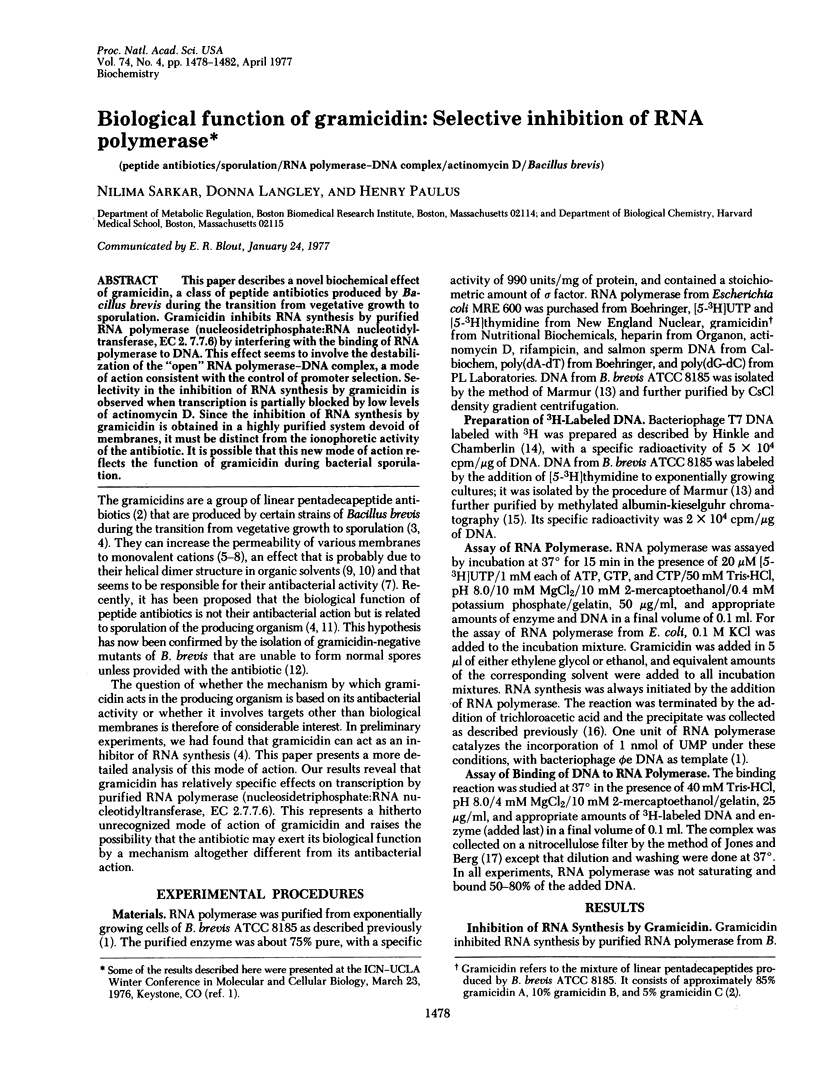
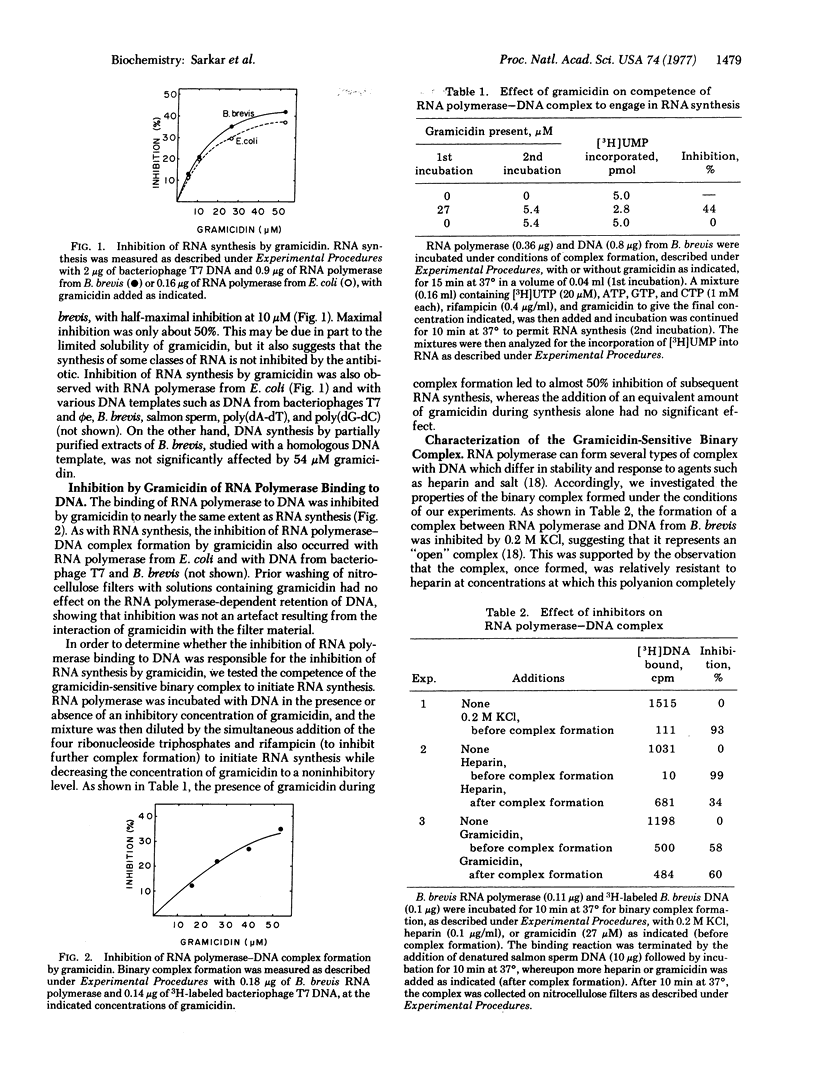
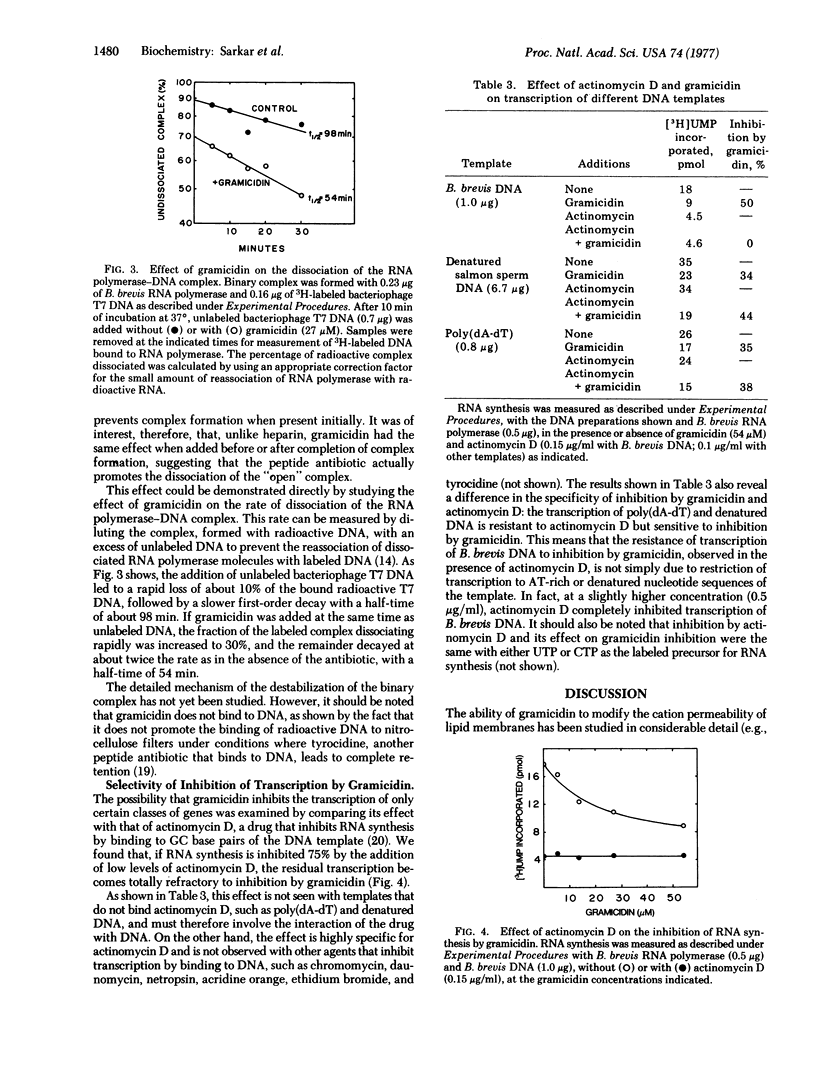
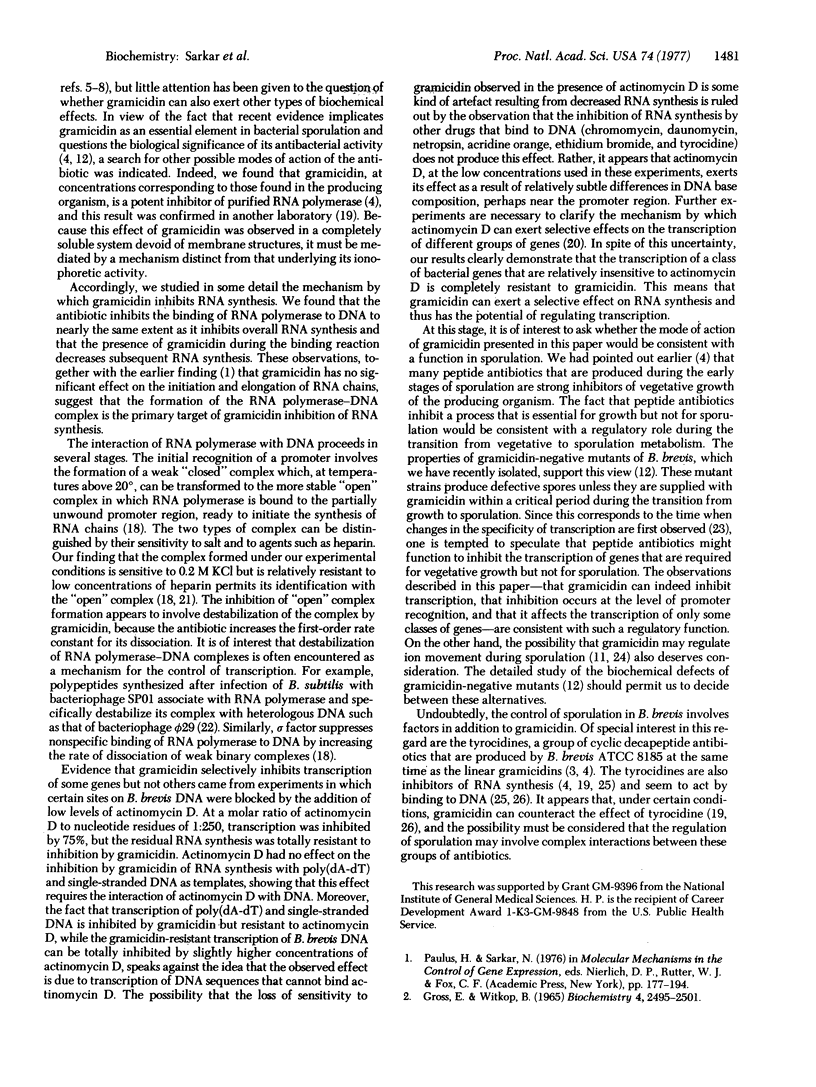
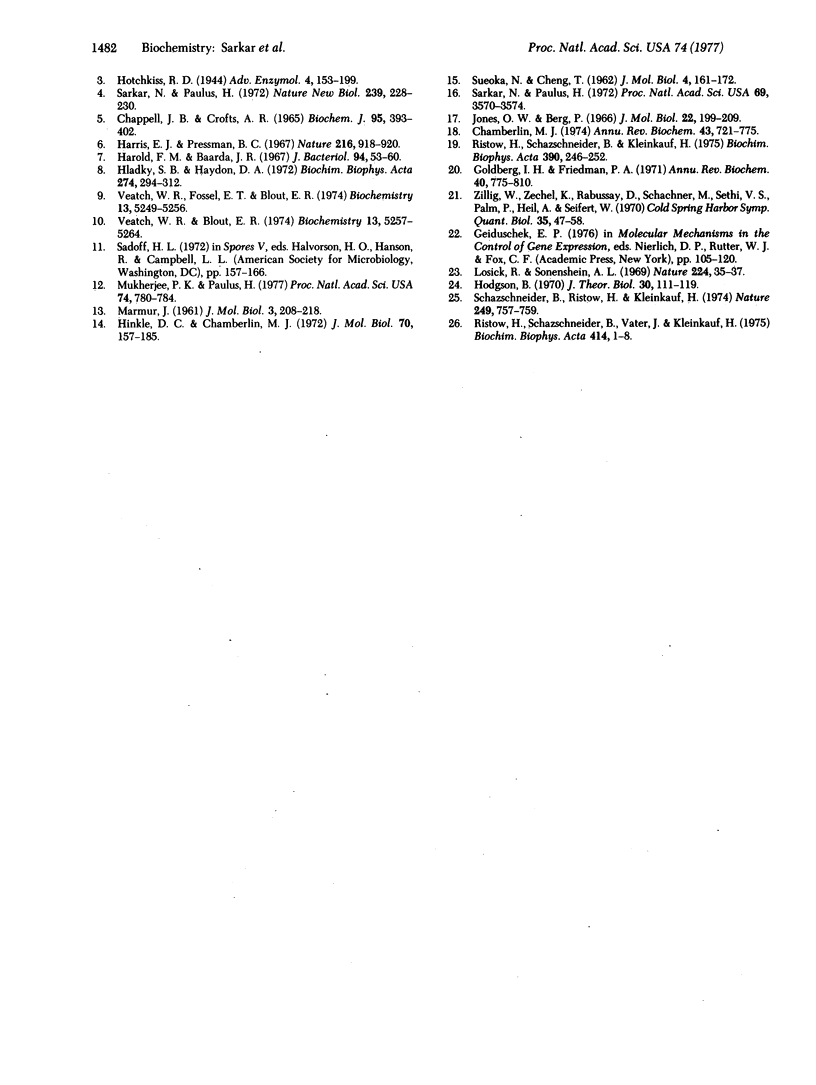
Selected References
These references are in PubMed. This may not be the complete list of references from this article.
- CHAPPELL J. B., CROFTS A. R. GRAMICIDIN AND ION TRANSPORT IN ISOLATED LIVER MITOCHONDRIA. Biochem J. 1965 May;95:393–402. doi: 10.1042/bj0950393. [DOI] [PMC free article] [PubMed] [Google Scholar]
- Chamberlin M. J. The selectivity of transcription. Annu Rev Biochem. 1974;43(0):721–775. doi: 10.1146/annurev.bi.43.070174.003445. [DOI] [PubMed] [Google Scholar]
- Goldberg I. H., Friedman P. A. Antibiotics and nucleic acids. Annu Rev Biochem. 1971;40:775–810. doi: 10.1146/annurev.bi.40.070171.004015. [DOI] [PubMed] [Google Scholar]
- Harold F. M., Baarda J. R. Gramicidin, valinomycin, and cation permeability of Streptococcus faecalis. J Bacteriol. 1967 Jul;94(1):53–60. doi: 10.1128/jb.94.1.53-60.1967. [DOI] [PMC free article] [PubMed] [Google Scholar]
- Harris E. J., Pressman B. C. Obligate cation exchanges in red cells. Nature. 1967 Dec 2;216(5118):918–920. doi: 10.1038/216918a0. [DOI] [PubMed] [Google Scholar]
- Hinkle D. C., Chamberlin M. J. Studies of the binding of Escherichia coli RNA polymerase to DNA. I. The role of sigma subunit in site selection. J Mol Biol. 1972 Sep 28;70(2):157–185. doi: 10.1016/0022-2836(72)90531-1. [DOI] [PubMed] [Google Scholar]
- Hladky S. B., Haydon D. A. Ion transfer across lipid membranes in the presence of gramicidin A. I. Studies of the unit conductance channel. Biochim Biophys Acta. 1972 Aug 9;274(2):294–312. doi: 10.1016/0005-2736(72)90178-2. [DOI] [PubMed] [Google Scholar]
- Hodgson B. Possible roles for antibiotics and other biologically active peptides at specific stages during sporulation of Bacillaceae. J Theor Biol. 1971 Jan;30(1):111–119. doi: 10.1016/0022-5193(71)90040-3. [DOI] [PubMed] [Google Scholar]
- Jones O. W., Berg P. Studies on the binding of RNA polymerase to polynucleotides. J Mol Biol. 1966 Dec 28;22(2):199–209. doi: 10.1016/0022-2836(66)90126-4. [DOI] [PubMed] [Google Scholar]
- Losick R., Sonenshein A. L. Change in the template specificity of RNA polymerase during sporulation of Bacillus subtilis. Nature. 1969 Oct 4;224(5214):35–37. doi: 10.1038/224035a0. [DOI] [PubMed] [Google Scholar]
- Mukherjee P. K., Paulus H. Biological function of gramicidin: studies on gramicidin-negative mutants. Proc Natl Acad Sci U S A. 1977 Feb;74(2):780–784. doi: 10.1073/pnas.74.2.780. [DOI] [PMC free article] [PubMed] [Google Scholar]
- Ristow H., Schazschneider B., Bauer K., Kleikauf H. Tyrocidine and the linear gramicidin. Do these peptide antibiotics play an antagonistic regulative role in sporulation? Biochim Biophys Acta. 1975 May 1;390(2):246–252. [PubMed] [Google Scholar]
- Ristow H., Schazschneider B., Vater J., Kleinkauf H. Some characteristics of the DNA-tyrocidine complex and a possible mechanism of the gramicidin action. Biochim Biophys Acta. 1975 Nov 18;414(1):1–8. doi: 10.1016/0005-2787(75)90120-3. [DOI] [PubMed] [Google Scholar]
- SUEOKA N., CHENG T. Y. Fractionation of nucleic acids with the methylated albumin column. J Mol Biol. 1962 Mar;4:161–172. doi: 10.1016/s0022-2836(62)80048-5. [DOI] [PubMed] [Google Scholar]
- Sarkar N., Paulus H. Function of peptide antibiotics in sporulation. Nat New Biol. 1972 Oct 25;239(95):228–230. doi: 10.1038/newbio239228a0. [DOI] [PubMed] [Google Scholar]
- Sarkar N., Paulus H. Nucleotide-dependent inactivation of RNA polymerase from Bacillus brevis. Proc Natl Acad Sci U S A. 1972 Dec;69(12):3570–3574. doi: 10.1073/pnas.69.12.3570. [DOI] [PMC free article] [PubMed] [Google Scholar]
- Schazschneider B., Ristow H., Kleinkauf H. Interaction between the antibiotic tyrocidine and DNA in vitro. Nature. 1974 Jun 21;249(459):757–759. doi: 10.1038/249757a0. [DOI] [PubMed] [Google Scholar]
- Veatch W. R., Blout E. R. The aggregation of gramicidin A in solution. Biochemistry. 1974 Dec 17;13(26):5257–5264. doi: 10.1021/bi00723a002. [DOI] [PubMed] [Google Scholar]
- Veatch W. R., Fossel E. T., Blout E. R. The conformation of gramicidin A. Biochemistry. 1974 Dec 17;13(26):5249–5256. doi: 10.1021/bi00723a001. [DOI] [PubMed] [Google Scholar]


